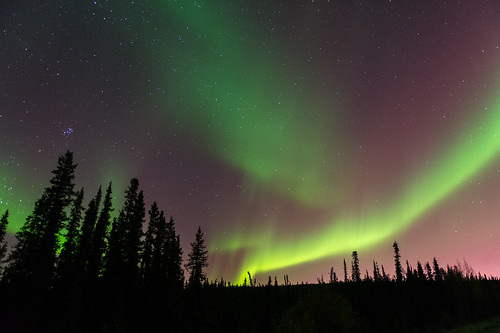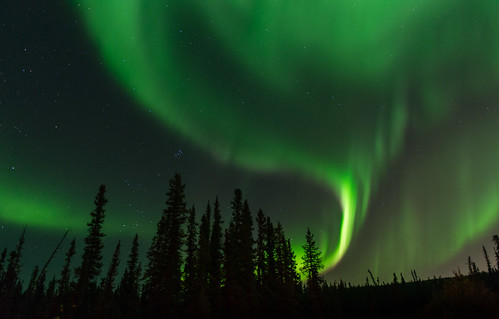 |
| A slightly longer shutter speed allowed additional colors to appear. 1/8 @ f2.8, ISO 3200. |
Just to be clear, the assignment that I'm getting paid for always comes first, which means that I really have to muster the energy to do personal work. This was certainly the case on a recent trip to Fairbanks, Alaska, to document Navy-sponsored Arctic research.
Prior to any trip I will conduct a web search looking for things to do and see at that location. Imagine my surprise when I kept seeing photographs of the Aurora Borealis, or Northern Lights. Was it possible that I would get the chance to not only see this, but photograph it? For some reason I thought you had to be much farther north.
 |
| The intensity of light was constantly changing which meant I had to keep adjusting shutter speed. 1/2 @ f2.8, ISO 3200. |
1. Getting the photograph means you might lose a little sleep. Rarely are the best outdoor or landscape photographs taken mid morning, just after a leisurely breakfast and before a long lunch. Most of the time getting the best means setting up before the sun rises and staying out after it sets. Of course there is still time for that leisurely lunch, and maybe a nap in the middle of the day, unless you are getting paid to be there, then you have to make the extra effort. So to photograph the Northern Lights I had to set my alarm for midnight, and not just one night, but for three nights in a row until I finally found success.
2. Shooting something for the first time, means experimentation. I had never photographed the Northern Lights, but I have photographed stars, so I knew that I first needed a location away from the city lights, which in Fairbanks meant about a ten minute drive. Ideally you would scout these locations during the day, but remember since I was on an assignment, I had to locate a safe and awesome location in the dark, which I fortunately did. On the second night it was clear and the sky was filled with stars, but I didn't see signs of the Aurora Borealis. However, just because I didn't see what I was looking for, didn't mean I wasn't going to still take pictures.
 |
| I did not realize that I had captured a faint glow of the Northern Lights on the second night until I downloaded and post processed my photos. 1/13 @f2.8, ISO 1600. |
4. Persistence pays off. On the third night I once again woke up at midnight and headed back to the same location as the previous night, only this time as soon as I stepped out of the car, even before my eyes adjusted to the darkness, I could see streaks of green in the sky. By the time I set up my tripod and camera, the lights were sweeping across the night sky. I started with the same camera settings as I had the previous night and could tell right away that I wasn't even close. Remember tip two, experiment and don't get flustered. This time instead of a standard night star setup of a 15-20 second exposure at ISO 3200, I was at a two to four second exposure at ISO 1600. Any longer on the exposure time and the lights were really soft because they were moving and "dancing" so fast. Given more time I probably would have experimented more with that longer exposure.
5. Look 360 degrees. At first I was really focused in one direction which had a good foreground of pine trees. It wasn't until I relaxed a bit, turned and started looking around, that I realized there were photo opportunities everywhere, even straight up. I just kept shooting with the Nikon 24-70mm and even though I did bring the 70-200mm with me, for some reason I left the 14-24mm lens in the room. In total, I spent around an hour taking pictures and if it wasn't for that pesky aforementioned assignment, I would have stayed all night.
 |
| Even shooting vertical at 24mm I was not able to capture everything I was seeing. 1/5 @ f 2.8, ISO 1600. |
Bonus tip: Many of the hotels in Fairbanks maintain a wake up list if you wish to be notified whether the Aurora Borealis is active on a particular night. My advice, just get out there and shoot; you may discover more in your photograph than you expected.
No comments:
Post a Comment